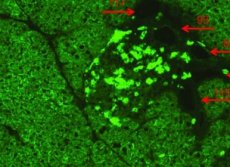Scientists have removed the world's first movie for the development of type 1 diabetes in real time
Last reviewed: 23.04.2024

All iLive content is medically reviewed or fact checked to ensure as much factual accuracy as possible.
We have strict sourcing guidelines and only link to reputable media sites, academic research institutions and, whenever possible, medically peer reviewed studies. Note that the numbers in parentheses ([1], [2], etc.) are clickable links to these studies.
If you feel that any of our content is inaccurate, out-of-date, or otherwise questionable, please select it and press Ctrl + Enter.

Scientists from the Institute of Allergy and Immunology La Hoya created the first film that shows the destruction of beta cells in type 1 diabetes in real time.
"We present the first images of the development of type 1 diabetes at the cellular level," the study's author Matthias von Herrat said. "The ability to see interactions in the pancreas of insulin-producing cells in real time significantly increases our ability to find effective methods for treating type 1 diabetes." - says the scientist.
A document on scientific results obtained by a team of scientists, along with cell films, was published in the journal Clinical Investigation. The films are freely available and can be seen на сайте www.jci.orghere.
These images give important information about the development of the disease, in particular, they show the causes of beta-cell destruction (underlying the development of type 1 diabetes).
In the film, you can see objects resembling ants that stroll through the forest in search of their victims. "Ants", in fact, are the T-cells of the immune system. "Victims" are insulin-producing beta cells, which T cells erroneously attack and destroy, which ultimately leads to the development of type 1 diabetes.
Innovative studies were carried out using a two-photon microscope using a new technique developed by Dr. Von Herrath, which allowed the microscope to be used directly in the pancreas.
In the films, the process of destruction of beta cells is especially interesting. T cells move randomly across the entire pancreas until they collide with beta cells, where they slow down and release toxic substances that eventually kill the beta cells. What is most surprising is that this "kiss of death" can take a long time.
Scientists also found that massive destruction of pancreatic cells occurs when the number of T cells reaches tens of millions. "These factors can explain the long pre-clinical stage of type 1 diabetes," said Dr. Von Herrath.
"This means that autoimmune attacks occur for many years before the number of beta cells falls below the critical threshold, leading to a clinical manifestation of the disease," he said, noting that 90% of the beta cells are destroyed in the human body before the symptoms manifest diabetes. From a therapeutic point of view, these studies show that scientists need to find a way to prevent T cell attacks in the pancreas.


 [
[